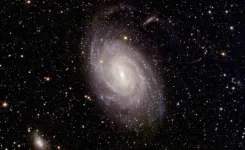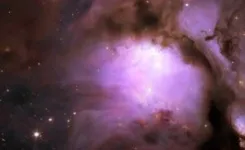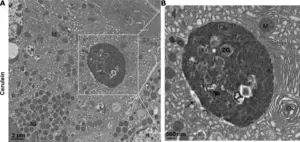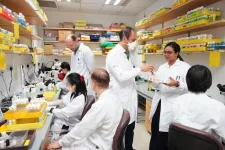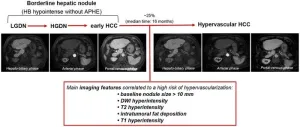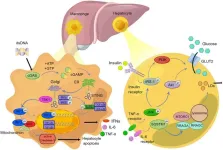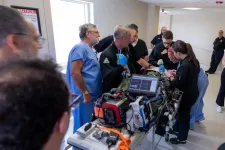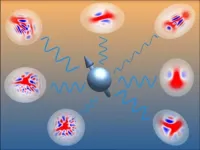(Press-News.org) European space mission Euclid has released early scientific papers based on observations made by the space telescope, along with five new astronomical images of the Universe, as the project sets about unravelling the secrets of the cosmos.
The new images are part of Euclid’s Early Release Observations (EROs) and accompany the mission’s first scientific data and 10 forthcoming science papers. Their publication comes less than a year after the space telescope’s launch and some six months after it returned its first full-colour images of the cosmos.
The scientific papers are based on observations and analysis of 17 targets and contain exciting scientific results including:
the discovery of free-floating new-born planets
newly identified extragalactic star clusters
new low-mass dwarf galaxies in a nearby cluster of galaxies
the discovery of very distant bright galaxies
The five new ERO images follow the release of an initial five images last November. The images obtained by Euclid are at least four times sharper than those that can be taken from ground-based telescopes. They cover large patches of sky at unrivalled depth, looking far into the distant Universe using both visible and infrared light.
The latest Euclid images include observations of:
Messier 78, a reflection nebula
Abell 2390 and Abell 2764, two giant clusters of galaxies
NGC 6744, a spiral galaxy very similar to the Milky Way
the Dorado Group, a loose agglomeration of galaxies
Speaking about the data release, Prof Peter Coles of Maynooth University’s Department of Theoretical Physics, the only Irish-based academic involved in the Euclid consortium, said: “Today's release of new data and technical papers from Euclid is exciting in itself but also marks the start, after months of painstaking calibration and testing of the instruments, of Euclid's main cosmological survey. We are on the threshold of a new era in cosmology.”
“Maynooth is the only University in Ireland to be involved in this mission and it is very exciting to be at the forefront of such an important scientific development.”
Launched from Cape Canaveral on July 1, 2023, Euclid’s mission is to map the distribution of distant galaxies across more than one-third of the sky to extract information about the constituents of the universe, and test whether current ideas about cosmic evolution are correct.
“Euclid is a unique, ground-breaking mission, and these are the first datasets to be made public – it’s an important milestone,” says Valeria Pettorino, ESA’s Euclid Project Scientist. “The images and associated science findings are impressively diverse in terms of the objects and distances observed. They include a variety of science applications, and yet represent a mere 24 hours of observations. They give just a hint of what Euclid can do. We are looking forward to six more years of data to come!”
The next thing to look forward to from Euclid is a taster for the main Euclid survey around March 2025. The first year of survey data (DR1) will be released in June 2026 while the full survey will be completed in 2031.
Prof Peter Coles is available to discuss Euclid and the recent data release.
END
Euclid space mission releases first scientific results and new images of the cosmos
The release marks the start of Euclid’s main survey, says physicist at Maynooth University, the only Irish university in the Euclid consortium. We are on the threshold of a new era in cosmology,” says MU’s Prof Peter Coles
2024-05-24
ELSE PRESS RELEASES FROM THIS DATE:
Sociodemographic heterogeneity in the associations of social isolation with mortality
2024-05-24
About The Study: Social isolation was associated with increased risks of all-cause, cardiovascular diseases, and malignant neoplasm mortality, with associations varying across populations. This study fills an important gap in research on social isolation, emphasizing its varied associations across demographic and socioeconomic groups.
Corresponding Author: To contact the corresponding author, Atsushi Nakagomi, M.D., Ph.D., email anakagomi0211@gmail.com.
To access the embargoed study: Visit our For The Media website at this link https://media.jamanetwork.com/
(doi:10.1001/jamanetworkopen.2024.13132)
Editor’s Note: Please ...
COVID-19 admission rates and changes in care quality in us hospitals
2024-05-24
About The Study: In this cross-sectional study, COVID-19 surges were associated with declines in hospital quality, highlighting the importance of identifying and implementing strategies to maintain care quality during periods of high hospital use.
Corresponding Author: To contact the corresponding author, Giacomo Meille, Ph.D., email giacomo.meille@ahrq.hhs.gov.
To access the embargoed study: Visit our For The Media website at this link https://media.jamanetwork.com/
(doi:10.1001/jamanetworkopen.2024.13127)
Editor’s Note: Please see the article for additional information, ...
Preterm and early-term delivery after heat waves in 50 US metropolitan areas
2024-05-24
About The Study: Preterm and early-term birth rates increased after heat waves, particularly among socioeconomically disadvantaged subgroups in this cohort study. Extreme heat events have implications for perinatal health.
Corresponding Author: To contact the corresponding author, Lyndsey A. Darrow, Ph.D., email ldarrow@unr.edu.
To access the embargoed study: Visit our For The Media website at this link https://media.jamanetwork.com/
(doi:10.1001/jamanetworkopen.2024.12055)
Editor’s Note: Please see the article for additional information, including other authors, author contributions and ...
Research spotlight: Virtual scribes reduced physicians’ time spent on electronic health records
2024-05-24
Lisa Rotenstein, MD, of the Department of Medicine at Brigham and Women’s Hospital, is the lead author of a new study published in JAMA Network Open, “Virtual Scribes and Physician Time Spent on Electronic Health Records.”
What question were you investigating?
We sought to understand the impact of virtual scribes (human scribes who are not physically present in the exam room with the physician and patient) on how physicians spend their time and which characteristics are associated with physicians responding best to scribes.
What methods or approach did you use?
We studied the experiences of 144 physicians across specialties treating patients ...
Duke-NUS researchers develop new light-controlled ‘off switch’ for brain cells
2024-05-24
Researchers from Duke-NUS Medical School have found that a new class of light-sensitive proteins are capable of turning off brain cells with light, offering scientists an unprecedentedly effective tool to investigate brain function. The study, recently published in Nature Communications, opens exciting new opportunities to apply optogenetics to investigate the brain activity underlying neurodegenerative and psychiatric disorders such as Parkinson’s disease and depression.
Optogenetics is a technique where specific cells are bioengineered to include light-sensitive proteins that act as switches, allowing ...
Liver lesions at risk of transformation into hepatocellular carcinoma in cirrhotic patients
2024-05-24
Hepatocellular carcinoma (HCC) represents a significant global health burden as one of the most common malignancies in individuals with chronic liver disease or cirrhosis. This malignancy evolves through a multistep process, beginning with dysplastic nodules (DNs) and early HCC, progressing to overt HCC. Recent advancements in liver imaging, particularly the use of hepatocyte-specific contrast agents, have enhanced the detection of these precursor lesions, known as borderline hepatic nodules. These nodules, especially those hypointense in the hepatobiliary phase (HBP) without arterial phase hyperenhancement (APHE), present ...
Update on the STING signaling pathway in developing nonalcoholic fatty liver disease
2024-05-24
Nonalcoholic fatty liver disease (NAFLD) has become the most prevalent chronic liver condition worldwide, affecting about 25% of the global population due to the increasing rates of obesity and metabolic syndrome. NAFLD encompasses a spectrum of liver conditions ranging from simple hepatic steatosis to nonalcoholic steatohepatitis (NASH), which can progress to fibrosis, cirrhosis, and hepatocellular carcinoma (HCC). Despite its prevalence, there are limited effective treatment options available. Inflammation driven by metabolic disturbances is a key factor in the development and progression of ...
Autonomous medical intervention extends ‘golden hour’ for traumatic injuries with emergency air transport
2024-05-24
For the first time, a closed loop, autonomous intervention nearly quadrupled the “golden hour” during which surgeons could save the life of a large animal with internal traumatic bleeding while in emergency ground and air transport.
This breakthrough in trauma care, announced today in Intensive Care Medicine Experimental by physician-scientists at the University of Pittsburgh School of Medicine and funded by the U.S. Department of Defense, has enormous potential for saving the lives of traumatically injured ...
More than spins: Exploring uncharted territory in quantum devices
2024-05-24
Many of today’s quantum devices rely on collections of qubits, also called spins. These quantum bits have only two energy levels, the ‘0’ and the ‘1’. However, spins in real devices also interact with light and vibrations known as bosons, greatly complicating calculations. In a new publication in Physical Review Letters, researchers in Amsterdam demonstrate a way to describe spin-boson systems and use this to efficiently configure quantum devices in a desired state.
Quantum devices use the quirky behaviour of quantum ...
SG ramps up cancer fight with S$50 million in national grant funding for precision oncology
2024-05-24
Singapore, 24 May 2024 – Two multi-institution and multidisciplinary Singapore teams of clinician-scientists and researchers have been awarded grants of S$25 million each, by the Singapore Ministry of Health through the NMRC Office, MOH Holdings Pte Ltd, under the NMRC Open Fund-Large Collaborative Grant (OF-LCG) programme. The S$50 million support for cancer research establishes the SYMPHONY 2.0 and Colo-SCRIPT research programmes to drive precision oncology research in Singapore aimed at improving the understanding, diagnosis and treatment of lymphoma and colorectal cancer.
Led by the ...
LAST 30 PRESS RELEASES:
Singapore scientists discover lung cancer's "bodyguard system" - and how to disarm it
Bacteria use wrapping flagella to tunnel through microscopic passages
New critique prompts correction of high-profile Yellowstone aspen study, highlighting challenges in measuring ecosystem response to wolf reintroduction
Stroke survivors miss critical treatment, face greater disability due to systemic transfer delays
Delayed stroke care linked to increased disability risk
Long term use of anti-acid drugs may not increase stomach cancer risk
Non-monetary 'honor-based' incentives linked to increased blood donations
Natural ovulation as effective as hormones before IVF embryo transfer
Major clinical trial provides definitive evidence of impacts of steroid treatment on severe brain infection
Low vitamin D levels shown to raise risk of hospitalization with potentially fatal respiratory tract infections by 33%
Diagnoses of major conditions failing to recover since the pandemic
Scientists solve 66 million-year-old mystery of how Earth’s greenhouse age ended
Red light therapy shows promise for protecting football players’ brains
Trees — not grass and other greenery — associated with lower heart disease risk in cities
Chemical Insights scientist receives Achievement Award from the Society of Toxicology
Breakthrough organic crystalline material repairs itself in extreme cold temperatures, unlocking new possibilities for space and deep-sea technologies
Scientists discover novel immune ‘traffic controller’ hijacked by virus
When tropical oceans were oxygen oases
Positive interactions dominate among marine microbes, six-year study reveals
Safeguarding the Winter Olympics-Paralympics against climate change
Most would recommend RSV immunizations for older and pregnant people
Donated blood has a shelf life. A new test tracks how it's aging
Stroke during pregnancy, postpartum associated with more illness, job status later
American Meteorological Society announces new executive director
People with “binge-watching addiction” are more likely to be lonely
Wild potato follows a path to domestication in the American Southwest
General climate advocacy ad campaign received more public engagement compared to more-tailored ad campaign promoting sustainable fashion
Medical LLMs may show real-world potential in identifying individuals with major depressive disorder using WhatsApp voice note recordings
Early translational study supports the role of high-dose inhaled nitric oxide as a potential antimicrobial therapy
AI can predict preemies’ path, Stanford Medicine-led study shows
[Press-News.org] Euclid space mission releases first scientific results and new images of the cosmosThe release marks the start of Euclid’s main survey, says physicist at Maynooth University, the only Irish university in the Euclid consortium. We are on the threshold of a new era in cosmology,” says MU’s Prof Peter Coles
